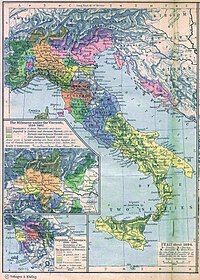User:Tommaisey/Renaissance draft/Cruft
Italian Renaissance Intro
[edit]The development of the Italian Renaissance was intertwined with the intellectual movement known as Renaissance humanism and with the history of the fiercely independent and combative urban societies of the city-states of central and northern Italy in the 13th to 16th centuries. Florence, Italy can be considered the birthplace of the Renaissance for several reasons.
The first two or three decades of the 15th century saw the emergence of a rare cultural efflorescence, particularly in Florence. This 'Florentine Enlightenment' (Holmes) was a major achievement. It was a classical, classicizing culture which sought to live up to the republican ideals of Athens and Rome. Sculptors used Roman models and classical themes. This society had a new relationship with its classical past — it felt it owned it and revived it. Florentines felt akin to 1st century BC republican Rome. Rucellai wrote that he belonged to a great age; Leonardo Bruni's Panegyric to the City of Florence expresses similar sentiments. There was a genuine appreciation of the plastic arts—pagan idols and statuary—with nudity and expressions of human dignity. Painting took huge leaps forward from the works of Giotto through Fra Angelico, Masaccio, Masolino, Piero della Francesca, and many others.

A similar, parallel movement was also occurring in the arts in the early 15th century in Florence—an avant-garde, classicising movement involving many of the same close community of people. Valla said that, as Latin was revived, so was Latin architecture — for example, the Palazzo Rucellai built by Leone Battista Alberti. Valla felt that Brunelleschi was the greatest architect since Roman times.
Sculpture was also revived, in many cases before the other arts. There was a very obvious classicism about contemporary sculpture, and highly true-to-life figures were being sculpted. Often biblically-themed sculpture and paintings included recognizable Florentines. Mention should be made of the competition to sculpt bas-relief bronze panels for the baptistery in Florence. The winner of the competition was Lorenzo Ghiberti, whose naturalistic and elegantly expressive work won over Brunelleschi's entry. Brunelleschi went on to give up sculpture and become one of the world's most significant architects, designing the Duomo of Florence.
The nascent philosophy of nominalism also played a part, and can be demonstrated by the attention to detail in the observation of nature evident in many paintings of the time.
Classicism was applied both to literature and to the arts. Alberti felt that he had played a major part, as had Brunelleschi and Masaccio. The list of artists who contributed to the flowering of Italian art during this period is long and varied, and must also include Gentile de Fabriano, Fra Angelico, Lorenzo da Monaco, Fra Filippo Lippi, Masolino, and Giovanni di Paolo.
